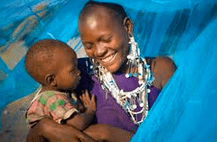Humanity has made impressive gains against Malaria in the past 12 years, but unless funding is scaled up we will never rid endemic regions from the disease.
That’s the one sentence summary of the World Health Organization’s 2012 World Malaria Report, out today, which warns that a looming budget crunch may undermine our global fight against malaria.
Here’s Chris Helfrich, Director of the United Nations Foundation’s Nothing But Nets campaign.
Worldwide, funding to stop malaria and the procurement and delivery of long-lasting, insecticide-treated bed nets are slowing down, from 145 million nets in 2010 to 66 million nets this year. We are facing a critical moment in the fight against malaria. Now is the time to sustain the gains against this deadly disease and distribute more life-saving bed nets to the families who need them.
Campaigns such as Nothing But Nets and investments in The Global Fund to Fight AIDS, Tuberculosis and Malaria and the President’s Malaria Initiative are more important than ever. There have been huge gains against malaria since 2000, as funding jumped from $100 million in 2000 to $1.8 billion in 2012. But an estimated $5 billion is needed to keep every family at risk safe from malaria.
In 2010, the last year for which our data is complete, malaria sickened 219 million people and killed 660,000–mostly children under 5 years old in Africa. Yet, thanks to a sharp focus on Malaria prevention and treatment over the past decade, 1.1 million lives have been saved. Interventions like insecticide treated bed nets and indoor residual spraying to prevent malaria and artemisinin combination therapies to treat malaria are a big reason for this progress.
…But funding for these interventions are starting to flatline for the first time since the world got serious about Malaria 10 years ago. The WHO says an estimated $5.1 billion is needed every year between 2011 and 2020 to achieve universal access to malaria treatment and prevention. Right now, global funding levels are less than half that — $1.8 billion — and not increasing.
$2.3 billion is a significant sum of money, but it is pocket change in budgetary terms. (For comparison’s sake, it is about 0.003% of the budget of the US Department of Defense.) I realize we are in a tight budgetary environment, but surely we can find $2.3 billion a year for interventions we know will save millions of lives.
